| In July we began a two month exploration of the Mississippi River by traveling the Great River Road from its mouth on the Gulf of Mexico northward to Minnesota. And while 'ole blue worked well on this trip we have decided that she is getting worn out from these long road trips and is also a bit small to be our permanent residence. So if all goes well, we will find new owners for her and we can search for a newer rig with more storage and elbow room. Here are some of our most memorable moments on the first half of our River Road experience.
Keep in touch by clicking here Larry and Glorine.
|
|







|
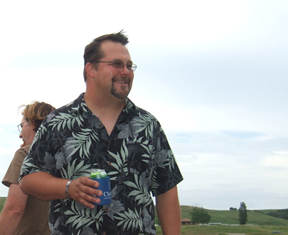 |
|
| Thanks to Larry's nephew, Randy we got a week of free RV hookups at Jack's old place west of Mandan over the 4th of July. It was great to have our own bed, refrigerator, etc., but also use their home to take showers and do laundry. Thank you Randy and Marla. |
On Friday before the fourth, Randy and Marla invited their family and friends out for a fish fry. The fish were caught earlier that day and could not have been fresher. The fish and all the fixings were great. Here are a few candid shots of the evening. As the sun set, fireworks went off and we even got in a couple rounds of Pinochle. |
 |
 |
| Who are those old geezers? Larry, along with about 40 of his high school classmates had their 45th reunion in Mandan. It was good seeing old classmates, even though it took awhile to recognize some of them. |
We used the RV to take Larry's family and spouses (seven in all) to Dickinson to spend time with Larry's twin Lorraine. She prepared a noon meal that was bigger and better than most served for evening dinner. It was a great outing and a chance to see some of Frank and Lorraine's new antiques. We took some of the back roads and reminisced about the people who lived near our old farm west of Mandan. |
 |
 |
| While visiting with Glorine's brother Ray at their new home south of Mandan, we went for a walk in the neighborhood with Ray and their sister Marlene. Their home is in a new development with beautiful view lots overlooking farm and ranch land and the buttes of western North Dakota. |
While at Ray's, we got to spend time with Ray and Ida's youngest son, Mike and his wife Molly and their three kids. They live in Fort Collins, CO and drove up for Mike's class reunion. |
 |
 |
| After leaving North Dakota we drove to Louisiana to start our Great River Road tour. On the way there we made a couple of stops. Our first night was with Darwin and Jane from Sioux Falls, South Dakota, a couple we met through mutual friends in Ajijic. They were in Ajijic on a week+ vacation and during that time we must have gotten together no less than four times. After breakfast, they took us around Sioux Falls including the falls themselves, which is where this picture was taken. |
From Sioux Falls, it was a short trip to Waverly, Nebraska to spend a couple of days with Larry's brother Bob, Francie and their family. They had a family picnic in their backyard about the time we arrived. We also took Bob and Francie to see the type of motor home that we hope is in our near future and got to watch two of their grandkids play baseball. The visit was nice but way too short. |
 |
 |
| Glorine's oldest sister Sally is remarried and now living in Shreveport, Louisiana. It was a two-day trip from Nebraska and noticeably hotter and more humid. We met Les for the first time and had a great time playing cards, seeing the sights of Shreveport (including a couple of riverboat casinos). It was a nice visit. |
From Shreveport, we started our adventure up the Mississippi River on the GREAT RIVER ROAD (GRR), which touches ten states along its path. The river is the third largest water shed in the world and is 2,300 miles long from its headwaters at Lake Itasca, Minnesota to its mighty mouth at the Gulf of Mexico. In addition to all the history and culture, the road includes five National Scenic Byways which helped make this trip one of the most enjoyable trips we have ever taken. |
|
 |
| The swamp! Our first stop on the GRR was at Lake Fausse Pointe State Park near Lafayette Louisiana. It is in the heart of Cajun Country and sets along side of the Atchafalaya (ay-chaw-faw-lie-ah) Basin, the largest river swamp in North America and so massive that Interstate 10 has 18-1/2 miles of bridges to cross it. We thought about a swamp tour, but chickened out. And here is the reason--alligators and lots of them. The swamp is home to over forty reptile species and countless endangered wildlife and water fowl. So instead of a boat ride we walked along a mile long boardwalk that took us into the swamp land. It was cool and a lot less scary! |
Plantation Country! Louisiana was the land of cotton, which was one of the most lucrative, but most labor intensive crops grown at the time. Slavery solved that latter issue and the land owners amassed unbelievable wealth. Here is one of many plantation homes that line the Mississippi River. Lavishly eloquent would be an understatement. While some are still in the family, most are now B&Bs or state museums. |
| |
|
| Zydeco (zie-dah-coh) breakfast--one of the 1,000 things to do before you die. Just by luck we learned of a local custom at the Caf� des Amis restaurant near Lafayette. They open about 7:00 a.m. every Saturday morning and loads of people show up to eat, drink, listen and dance to Zydeco music. These two women with Glorine drove 35 miles from Baton Rouge to partake and invited us to have breakfast with them. This folk music is fast tempo and includes a guitar, button accordion, and a washboard. It didn't matter who did the asking, everyone would get up and dance. By 10:00 it was hot and humid and the sweat was rolling off people. While the booze, music, and dancing was exciting, the breakfast was unusual-grilled biscuit with crawfish etouffee, cheese grits, and biscuit with grilled boudin patty. |
After four hours of Zydeco breakfast, we drove to New Orleans and spent the night at a hotel in the French Quarters. This quaint area saw some of the devastation of Katrina, but was spared what you will see latter. As their number one tourist attraction, they made every effort to get the French Quarters back to normal. Anyone for Raw Oysters on the half shell at Felix Restaurant or coffee and beignet (a doughnut like dessert loaded with powder sugar) at Caf� Du Monde, established in 1862 and is open 24/7. We capped off the day with a trolley tour, which began operation in 1893 and took in St. Charles and Canal Street. |
|
 |
| Katrina is the newest tourist attraction which highlights the Ninth Ward which took the brunt and the aftermath of the hurricane. The Ninth Ward is a distinctive section of New Orleans located in the easternmost downriver portion of the city and is the largest of the 17 wards that make up New Orleans. While all of New Orleans is below sea level, the Ninth Ward is the deepest elevation, which meant houses and business sat in water up to the roof tops for nearly a month. Some progress in restoration is being made, but because of the poverty that exists in this area, the progress is exceedingly slow. One of the most famous residents of the Ninth Ward is Fat's Domino. Because of his personal wealth, he was able to rehabilitate his home. |
Another unique sight are the cemeteries, all built above ground because of the high water table. Blocks and blocks of monuments built to memorialize the dead. Some of these monuments, by today's standards, would cost up to $1,000,000. These cemeteries were laid out like small towns with streets and avenues. Quite a unique experience! |
 |
 |
| Because of the massive delta along the Gulf of Mexico where the river drains into the Gulf, there are no roads that go to the very tip of the mouth. We drove along the river south of New Orleans, but with the dikes and large industries lining the river, we did not get any good views of the river. However, we discovered the Port of New Orleans is the only deepwater port in the United States served by six class one railroads, which gives users direct rail service to anywhere in the country. The Mississippi River moves about 500 million tons of cargo each year � including chemicals, coal, timber, iron, steel and more than half of the nation�s grain exports.
|
So what is Cajun Country? Back in the 1533, when the British took over the French controlled Nova Scotia, most if not all of the French settlers, known as L'Acadians. They were given an ultimatum to either swear allegiance to the British Crown and forsake their Catholic faith or be exiled. Most refused and were thus forced to leave behind everything they owned and where herded onto ships without any regard to family ties, and relocated to France and parts of the original 13 colonies. Eventually many settled in or near the swamplands of Louisiana, which was then owned by France. Over the years, these people have evolved from L'Arcadia to Cajun. While touring different areas of this region, we noticed many still spoke French. |
 |
|
| Louisiana, home of Tabasco! Interesting things one learns during a life on wheels. South of our campsite, we discovered Canary Island, home of Tabasco, a company owned by the same family since after the Civil War. Due to an abundance of salt mines, this seemed to be the perfect spot to start this spicy business. Although, most of the hot peppers are grown in the Mexican state of Tabasco, peppers are shipped to Canary Island, processed and shipped throughout the World. |
Henry Wadsworth Longfellow wrote Evangeline, A Tale of Acadie, a poem about the plight of the Arcadians. The long moss of the trees is common in the swamp and a part of the poem. The state of Louisiana bought an old plantation and turned into a state park in commemoration of both the poem and the Arcadians. Here we are touring this park.
"Sleep tight and don't let the bed bugs bite" is an old saying when beds were made of rope--the tighter the rope the firmer the mattress. Another cool device is this fan that is over the dining table used to create a breeze and keep the bugs away. Glorine is portraying a slave whose job it was to pull the rope during meal time. |
| |
|
| St. Francisville is noted as one of the "must see" towns in Louisiana. The town is located north of Baton Rouge and most of its homes are listed in the national registry of historic buildings. And it was worth the time we spent walking through the historic area taking more pictures than we could ever use. |
On the out skirts of St. Francisville is the state-owned Rosedown Plantation State Historic Site, built in 1835. What makes this plantation so neat is that 90% of the furnishings are original, there are a dozen original outbuildings, a phenomenal garden and in-door plumbing making it very innovative for its day. |
| |
|
| This home that was never completed. The dreams of a cotton grower were cut short when the Civil War began. He was in the middle of constructing this six story, hexagon home with features rarely seen in today's homes. While the exterior structure was completed, the only floor that was finished was the main floor. The detail were impeccable. Each brick was cut to fit the odd shape of the home. One of the fun things we saw was a swinging baby cradle on the front porch. The home was donated to the city of Natchez, MS with the stipulation that is would remain as is. |
Natchez was once one of the major inland shipping ports that lined the Mississippi River. After the American Revolution through the 1820, material was shipped by wagons to inland towns. One such route was the Natchez Trace, a trading route to Nashville, Tennessee, which today is a National Scenic Byway. While we only drove on it for 50 miles or so, it was one of the most beautiful roads we traveled. Along the way we toured the Emerald Mound, which was built around 1300 A.D. It was the second largest Indian temple mound in the United States and used for civic processions, ceremonial dances and religious rituals. The other unique building we saw was built in 1780 as an inn for people who traveled along the Natchez Trace. After the route was abandoned, this home became a plantation owned by five generations of the same family up to 1944. |
| |
 |
| Our next stop was Vicksburg, MS, home to the National Military Park. The park commemorates the campaign, siege, and defense of Vicksburg, where the Confederates surrendered on July 4, 1863, giving control of the Mississippi River to the North. It includes a museum, videos, a 16 mile tour road and a national cemetery. Over 20,000 soldiers were killed, wounded or missing in this battle alone. There are over 1,300 monuments dedicated to the various regiments that fought on both sides. They have a restored Union gunboat, which was credited in giving the Union Army the edge in this battle. This park was truly an unexpected and pleasant surprise. |
Mississippi was the second state to secede from the Union and its roots still run deep in their Confederate loyalties. The old county court house has been transformed into a museum dedicated to the Confederate States of America. Jefferson Davis, the first and only person to serve as its President, was a native of Mississippi. |
 |
 |
| Vicksburg has a large levee and throughout the downtown area there is a very large flood wall. Much of it is now covered with beautiful painted murals with small captions to denote facts about the mural. |
Here is just one of the many murals close up. It is a depiction of the Illinois Monument, which is one of largest monuments in the Military Park. |
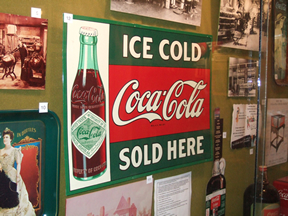 |
 |
| Vicksburg is home to Coca Cola bottling. Prior to this invention, Coke was only sold as a fountain drink. |
Lastly, Vicksburg is home to three riverboat casinos. |
| |
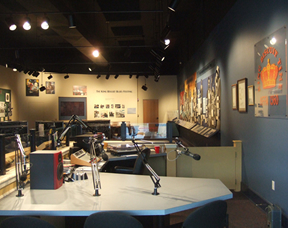 |
| They say that if the blues were born in New Orleans; they grew up in Clarksdale, Mississippi. Clarksdale is at the cross roads of US Highways 49 and 61 and pre-interstate highway was the place for Mississippi blues. We toured a museum dedicated to the blues, featuring Muddy Waters, who grew up here. We also went to Ground Zero, a blues nightclub owned by Morgan Freeman that has great blues musicians playing every weekend. In addition to the main band, young want-ta-be's took turns entertaining the audience. We sat at a long table with six sisters who were there celebrating one sister's birthday and a couple who were on "holiday" from Belgium. |
On our way to Tennessee, we spend one day touring Helena, Arkansas. In its day, it was a "happening" river town, but has pretty much dried up with most of its downtown buildings boarded up. It has a radio station that caters to blues enthusiasts, and periodically has blues musicians drop by and play live on air. We were there on a Sunday, which meant the Blues Museum was closed. We did get a taste for what was to come later on our trip, as this was one of the route for the Native Americans that were relocated from the southeastern part of the US to Oklahoma. All and all, it was a bit depressing. |
| |
 |
| In Memphis, we took a monorail from downtown to Mud Island, home of the Mississippi River Museum which focused mostly on the southern half of the river. Here is Glorine pretending to pilot a tug boat pushing 15 barges up river. The museum featured a miniature scale of the river that was five blocks long, including all its twists and turns. As we overlooked the river we snapped this picture of a paddle wheel tour boat and a tug boat with 15 barges filled with what would take 54 semis to haul. |
The Peabody Hotel features an unusual event twice a day--a duck walk. This tradition has been going on since the early 1930s, when a prankster put some ducks in the water fountain in the middle of the lobby. It was such a hit with the hotel guests, they kept it going all these years. Each morning the "duck master" leads the ducks from the roof top down the elevator to the water fountain (red carpet and all) and leads them back to the elevator each evening. As you can see, it is still a big hit for tourist like us. |
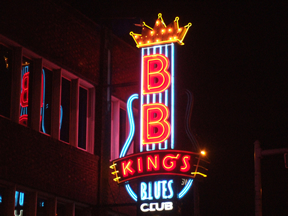 |
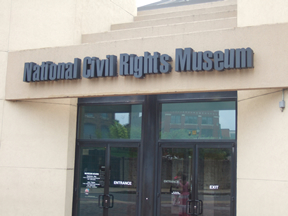 |
| Beale Street in Memphis is a miniture version of Bourbon Street in New Orleans. It is closed to traffic and filled with restaurants, bars, and novelty shops. Peabody is close by as is the Rock and Soul Museum, which we partook in. It is home to "Beales Street Blues Boy" BB King who started out in Memphis as a local DJ. |
About three blocks south of Beale Street is the home of the National Civil Rights Museum, located in the converted hotel where Martin Luther King was assassinated. The exhibits included the plight of blacks, particularly in the south. About half of the exhibits were about the struggle for equal rights and the remainder about the life and death of MLK. We were surprised that we were there for three hours. It was a very moving experience for us. |
 |
|
| Most of the exterior of the Lorraine Hotel is exactly as it was when King was shot on the balcony in front of his Room 306. We learned that there was a $50,000 bounty for anyone to kill him, so King knew that his days were numbered. His final speeches reflected a man at peace with himself and the work he had accomplished in his short 39 years of life. |
A few miles away was another place that became a defining moment in the lives of many of us growing up in the 60s. It is the home of Sun Studio, where Elvis Presley, Jerry Lee Lewis, and Johnnie Cash all got their start. The studio is now a museum filled with memorabilia of sound systems, guitars, and other musical instruments used by the stars. Here is Larry trying his hand at drums - nice try. From here we drove back to the RV in a rain storm that left 5" of rain and a tornado that touched down. Fortunately, it did not affect us. This also marked the first half of our Great River Road tour which has been quite remarkable. |

























